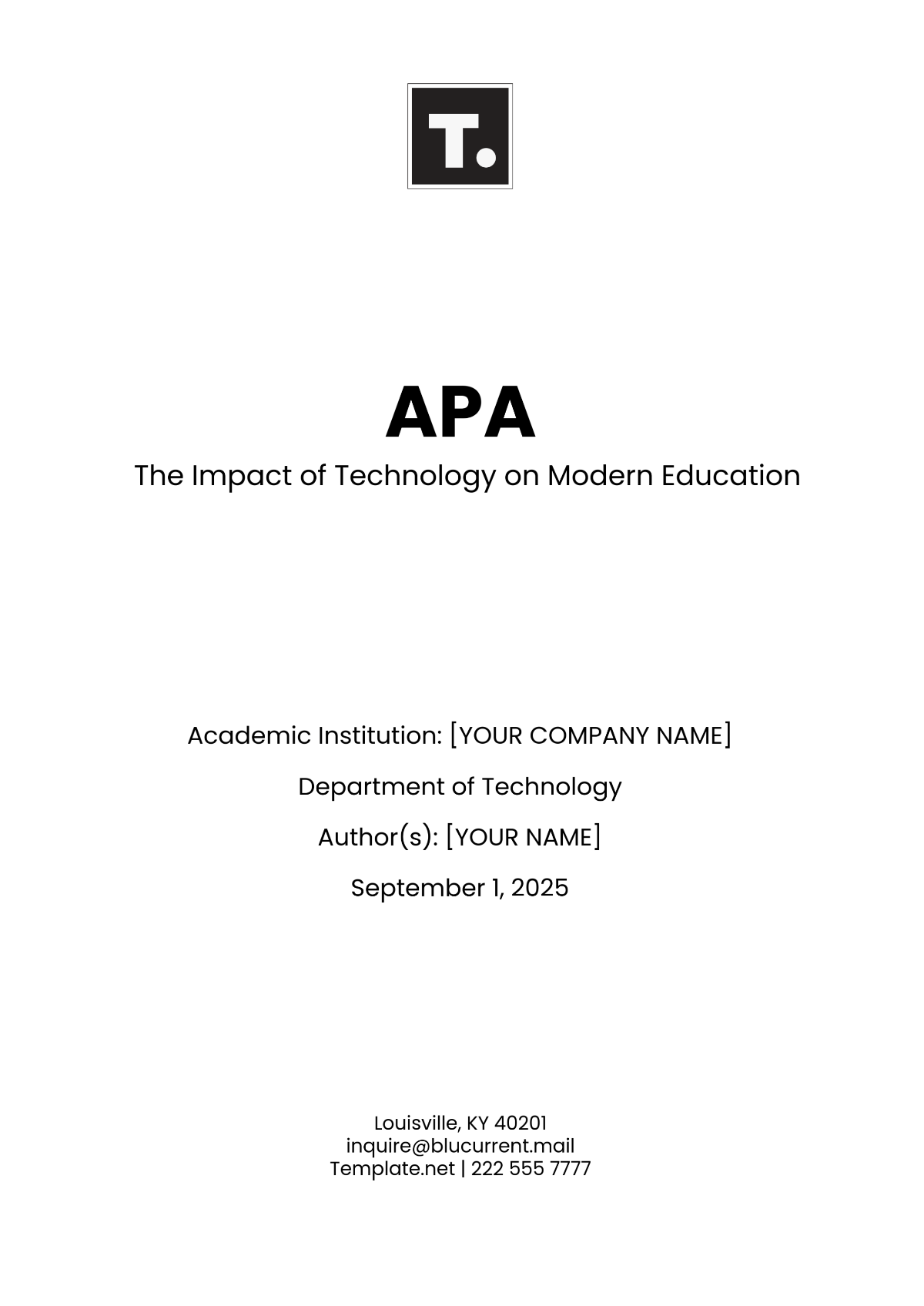Free APA Style White Paper

Prepared By: [YOUR NAME]
I. Executive Summary

Technology has revolutionized education by enhancing accessibility, engagement, and personalized learning experiences. However, challenges such as the digital divide and privacy concerns persist. Despite these challenges, technology holds the potential to democratize education and empower learners worldwide.
II. Introduction
The integration of technology into modern education has transformed the way students learn and educators teach. This white paper explores the profound impact of technology on education, examining its benefits, challenges, and future implications.
III. Background
In recent decades, advancements in technology have reshaped various industries, including education. The proliferation of internet-connected devices, educational software, and online learning platforms has created new opportunities for students and educators alike.
IV. Problem Statement
While technology offers numerous educational benefits, disparities in access to technology and digital literacy skills persist among students from different socio-economic backgrounds. Addressing these disparities is crucial to ensure that all students have equal opportunities to succeed in the digital age.
V. Methodology
This white paper synthesizes existing research, case studies, and expert opinions to analyze the impact of technology on modern education. Data sources include academic journals, government reports, and reputable educational organizations.
VI. Discussion
a. Enhancing Accessibility
Technology has expanded access to educational resources, breaking down geographical barriers and enabling distance learning.
Online platforms offer flexible learning options for non-traditional students, such as working adults and individuals with disabilities.
b. Improving Engagement
Interactive learning tools, such as educational games and virtual simulations, enhance student engagement and motivation.
Multimedia content and digital textbooks provide dynamic learning experiences that cater to diverse learning styles.
c. Personalizing Learning
Adaptive learning algorithms analyze student data to tailor instruction to individual needs, promoting mastery-based learning.
Learning analytics offer insights into student performance, allowing educators to provide targeted interventions and support.
Chart 1: Digital Learning Tools Adoption Rate
In 2050, only 55% of educators reported using digital learning tools in their classrooms.
By 2055, this number had increased to 70%, representing a 15% growth in adoption rate over five years.
The most commonly used digital tools include interactive whiteboards, educational software, and online learning platforms.
VII. Conclusion
The integration of technology into education represents a paradigm shift in teaching and learning. While challenges such as the digital divide persist, the benefits of technology-enhanced learning are undeniable. By addressing these challenges and harnessing the power of technology, we can create a more inclusive and equitable education system for all.
VIII. References
National Center for Education Statistics. (2058). Use of educational technology in U.S. public schools: 2057 (NCES 2018070). U.S. Department of Education. https://nces.ed.gov/pubs2018/2018070.pdf
Hew, K. F., & Brush, T. (2057). Integrating technology into K-12 teaching and learning: Current knowledge gaps and recommendations for future research. Educational Technology Research and Development, 55(3), 223–252.
Ravitz, J., Mergendoller, J., & Swan, K. (2053). PBL and technology: Tools to support inquiry-based learning. The Interdisciplinary Journal of Problem-based Learning, 7(1), 55–77.
IX. Appendices
Appendix A: Case Study - Implementation of Virtual Learning Environments
Case study report on the successful implementation of virtual learning environments in a rural school district.
Provides insights into the benefits and challenges of using technology to facilitate distance learning.
Appendix B: Survey Data - Educator Perceptions of Digital Learning Tools
Survey results summarizing educator perceptions of digital learning tools, including usage trends and satisfaction levels.
Includes qualitative feedback from educators on the effectiveness of various technology-enhanced learning resources.
- 100% Customizable, free editor
- Access 1 Million+ Templates, photo’s & graphics
- Download or share as a template
- Click and replace photos, graphics, text, backgrounds
- Resize, crop, AI write & more
- Access advanced editor
The APA Style White Paper Template from Template.net offers a professional format for your academic papers. Editable in our Ai Editor Tool, this template is customizable to suit your needs, ensuring your research meets APA guidelines effortlessly. Perfect for students and scholars, this template simplifies the process of creating APA-compliant papers.





























